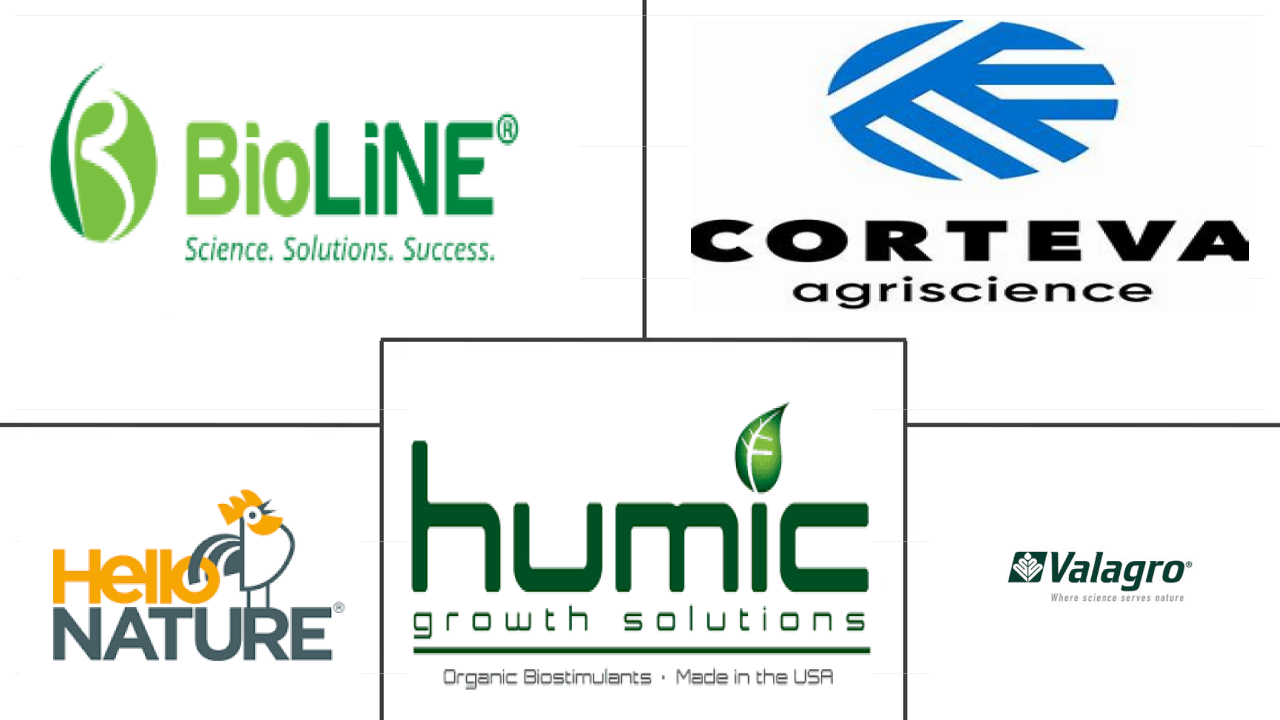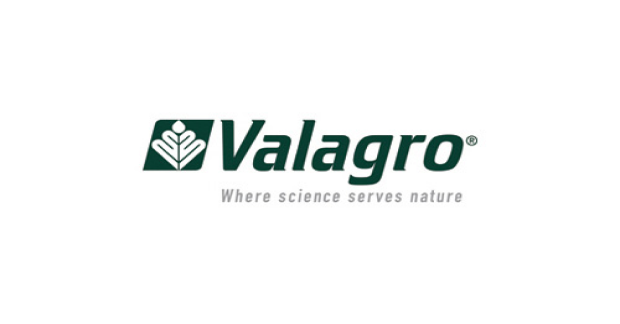Market Size of united states biostimulants Industry
|
|
Study Period | 2017 - 2029 |
|
|
Market Size (2024) | USD 0.53 Billion |
|
|
Market Size (2029) | USD 1.01 Billion |
|
|
Largest Share by Form | Protein Hydrolysates |
|
|
CAGR (2024 - 2029) | 13.52 % |
|
|
Fastest Growing by Form | Humic Acid |
Major Players |
||

|
||
|
*Disclaimer: Major Players sorted in no particular order |
United States Biostimulants Market Analysis
The United States Biostimulants Market size is estimated at 0.53 billion USD in 2024, and is expected to reach 1.01 billion USD by 2029, growing at a CAGR of 13.52% during the forecast period (2024-2029).
0.53 Billion
Market Size in 2024 (USD)
1.01 Billion
Market Size in 2029 (USD)
11.14 %
CAGR (2017-2023)
13.52 %
CAGR (2024-2029)
Largest by Form
37.33 %
value share, Protein Hydrolysates, 2023
Protein hydrolysates dominated United States biostimulants market in 2022 owing to their role in improving yield and quality traits in agricultural and horticultural crops.
Fastest by Form
14.21 %
Projected CAGR, Humic Acid, 2024-2029
Humic acids aid in enhancing root, leaf, and shoot growth and also promote seed germination. Row crops dominated the market accounting for 70.7% of the market share in 2022.
Largest by Crop Type
71.37 %
value share, Row Crops, 2023
Major row crops grown in the country include corn, wheat, rice, soybean and barley. Protein hydrolysates dominated the row crops segment with a market share of 37.2% in 2022.
Fastest by Crop Type
13.96 %
Projected CAGR, Horticultural Crops, 2024-2029
Potato, tomato, lettuce, cucumbers and watermelons are major horticulture crops grown in the country. Protein hydrolysates dominated the market with a share of 37.2% in 2022.
Leading Market Player
3.34 %
market share, Valagro USA, 2022

Valagro USA offers customized biostimulant products for different field crops and cash crops. YieldOn and MC LINE are major biostimulant brands offered by the company.
- The biostimulants market in the United States consists of many active ingredients, such as humic and fulvic acids, amino acids, protein hydrolysates, seaweed extracts, and other biostimulants like organic plants and animal derivatives.
- Protein hydrolysates held the highest share in the US biostimulants market, with a share of 37.3% in 2022. The market was valued at USD 70.1 million in 2022, with a consumption volume of 5.9 thousand metric tons. The use of protein hydrolysates can improve yield and quality traits in agricultural and horticultural crops, thus leading to their high share.
- Humic acids followed protein hydrolysates, accounting for a market share of 27.6% in 2022. Humic acids help improve the root system of crops such as soybean, wheat, rice, and maize; vegetable crops such as potato, tomato, cucumber, and pepper; and fruit crops such as citrus (Citrus limon) and grape (Vitis vinifera).
- The field crops held the maximum area under organic cultivation and accounted for a significant share of biostimulant consumption, i.e., 71.4% in 2022. These crops were followed by horticultural and cash crops, with shares of 27.5% and 1.1% in the same year, respectively.
- Despite the potentially positive effects on different crops reported in the scientific literature, there is little knowledge regarding biostimulant effects on commercially grown crops like citrus and strawberry and vegetables like tomato and capsicum, particularly in many states of the country, like Florida and California.
- The growing demand for organic products, the advancement of the agricultural industry, the increasing use of bio-based resources in farming, and supportive government policies drive the US market for biostimulants.
United States Biostimulants Industry Segmentation
Amino Acids, Fulvic Acid, Humic Acid, Protein Hydrolysates, Seaweed Extracts are covered as segments by Form. Cash Crops, Horticultural Crops, Row Crops are covered as segments by Crop Type.
- The biostimulants market in the United States consists of many active ingredients, such as humic and fulvic acids, amino acids, protein hydrolysates, seaweed extracts, and other biostimulants like organic plants and animal derivatives.
- Protein hydrolysates held the highest share in the US biostimulants market, with a share of 37.3% in 2022. The market was valued at USD 70.1 million in 2022, with a consumption volume of 5.9 thousand metric tons. The use of protein hydrolysates can improve yield and quality traits in agricultural and horticultural crops, thus leading to their high share.
- Humic acids followed protein hydrolysates, accounting for a market share of 27.6% in 2022. Humic acids help improve the root system of crops such as soybean, wheat, rice, and maize; vegetable crops such as potato, tomato, cucumber, and pepper; and fruit crops such as citrus (Citrus limon) and grape (Vitis vinifera).
- The field crops held the maximum area under organic cultivation and accounted for a significant share of biostimulant consumption, i.e., 71.4% in 2022. These crops were followed by horticultural and cash crops, with shares of 27.5% and 1.1% in the same year, respectively.
- Despite the potentially positive effects on different crops reported in the scientific literature, there is little knowledge regarding biostimulant effects on commercially grown crops like citrus and strawberry and vegetables like tomato and capsicum, particularly in many states of the country, like Florida and California.
- The growing demand for organic products, the advancement of the agricultural industry, the increasing use of bio-based resources in farming, and supportive government policies drive the US market for biostimulants.
| Form | |
| Amino Acids | |
| Fulvic Acid | |
| Humic Acid | |
| Protein Hydrolysates | |
| Seaweed Extracts | |
| Other Biostimulants |
| Crop Type | |
| Cash Crops | |
| Horticultural Crops | |
| Row Crops |
United States Biostimulants Market Size Summary
The United States biostimulants market is experiencing significant growth, driven by the increasing demand for organic products and advancements in the agricultural sector. Biostimulants, which include active ingredients such as humic and fulvic acids, amino acids, and seaweed extracts, are gaining traction for their ability to enhance crop yield and quality. Protein hydrolysates and humic acids are among the most widely used biostimulants, with applications across various crops, including field, horticultural, and cash crops. Despite the potential benefits, there is limited knowledge about the effects of biostimulants on commercially grown crops in certain states, highlighting a gap in research and application.
The market is supported by favorable government policies and a growing trend towards organic farming, with a significant area under organic cultivation in states like California and Pennsylvania. The United States leads in organic product consumption, with a rising per capita spending on organic goods. This trend is fueled by increasing consumer awareness and preference for organic foods, particularly among younger and higher-income demographics. The market is fragmented, with key players like BioLine Corporation and Corteva Agriscience actively developing new products to meet the evolving demands of organic agriculture. Recent acquisitions and product launches further indicate a dynamic market landscape, poised for continued expansion.
United States Biostimulants Market Size - Table of Contents
-
1. MARKET SEGMENTATION (includes market size in Value in USD and Volume, Forecasts up to 2029 and analysis of growth prospects)
-
1.1 Form
-
1.1.1 Amino Acids
-
1.1.2 Fulvic Acid
-
1.1.3 Humic Acid
-
1.1.4 Protein Hydrolysates
-
1.1.5 Seaweed Extracts
-
1.1.6 Other Biostimulants
-
-
1.2 Crop Type
-
1.2.1 Cash Crops
-
1.2.2 Horticultural Crops
-
1.2.3 Row Crops
-
-
United States Biostimulants Market Size FAQs
How big is the United States Biostimulants Market?
The United States Biostimulants Market size is expected to reach USD 533.97 million in 2024 and grow at a CAGR of 13.52% to reach USD 1.01 billion by 2029.
What is the current United States Biostimulants Market size?
In 2024, the United States Biostimulants Market size is expected to reach USD 533.97 million.

